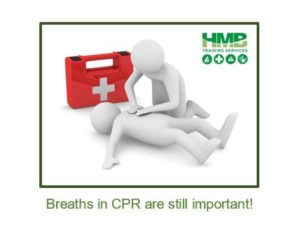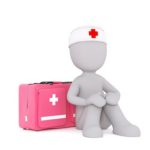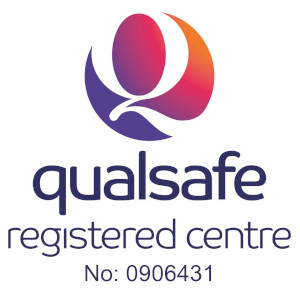Breaths in CPR are still important but why?
Do you get told that breaths in CPR are not needed? Do we even need to complete mouth-to-mouth in CPR? Please read further to see how important breaths in CPR really are!
During COVID lockdown, the Resuscitation Council, put a stop to giving breathes – Mouth-to-mouth during this time. Even 999 call handlers were saying no to breathes through their instructions. However, on our courses throughout COVID we were still teaching breathes, and sharing the importance on giving breathes during CPR.
On our courses, we have had many remarks and discussions as to why we do breaths in CPR. Our feedback from learners; they have been told or read that breaths in CPR are not needed and to only perform compressions.
The British Heart Foundation quotes ‘if you don’t want to give rescue breaths, Hands-only CPR is still likely to increase a person’s chance of survival. Never do nothing.’ There is evidence people refuse to do any CPR as the idea of mouth-to-mouth puts them off completing breaths in CPR. People are more willing to push on someone’s chest than to breathe into them.
Breathing into the casualties’ mouth or nose tops up the oxygen in their lungs. The combination of continuous cycles of 30 chest compressions followed by two breaths is called CPR (cardiopulmonary resuscitation).
However, breaths in CPR are incredibly important and further increase the casualty’s chances of survival.

If you are trained, you still need to give breaths in CPR but why?
If an adult has a Cardiac Arrest, the heart stops abruptly, they will still have residual oxygenated blood in their system and therefore their blood will be well oxygenated. In this situation compression-only CPR may be effective for the first few minutes, (roughly 3 or 4 minutes.) After this time, they will start to run out of oxygenated blood. The advice from the British Resuscitation Council and the British Heart Foundation remains – breathing for the casualty, combined with good compression’s, is the most effective form of CPR and gives the casualty the best chance of survival.
CPR by itself will not restart the heart, but it ‘buys time’ for the emergency medical services to reach the scene. Effective CPR more than doubles the chance of someone surviving a cardiac arrest.
On the other hand, children do not have the ability to retain oxygen in their system and therefore it is even more crucial that rescue breaths are administered. Thus, for children it is advised that you start with 5 rescue breaths – tilting the head to take the back of the tongue off the back of the throat and breathing into them to make their chest rise. This should then be followed by 30 chest compressions, pushing down on the chest by about a third and pushing hard and fast. Get an ambulance on the way and then continue: 2 breaths: 30 compressions….
Is it life-threatening not giving breaths in CPR?
Have you ever tried holding your breath as long as you can? Imagine how excruciating those last few seconds feel before taking a big gasp for air. When the heart stops beating, every cell in the body is going through a similar struggle, ‘gasping’ for oxygen.
The brain needs oxygen to function. The act of CPR keeps oxygenated blood flowing to the brain. Without oxygen, this vital organ can become permanently damage in less than 10 minutes.
Adding oxygen to the body is the purpose of taking breaths. When the casualties lungs are not supplied with enough oxygen to support life or when they are unable to breathe on their own. You may be the only person a casualty has if they need to get oxygen into their lungs. Fortunately, many first aid kits include with a CPR face cover or mask that helps stop the spread of fluids.
Bystander CPR Vs. Professional CPR
Because it is intended for unskilled bystanders who observe a cardiac arrest situation, hands-only is known as “bystander CPR.” Rescue breathing and chest compressions are used during a cardiac arrest by medical professionals who have received CPR training, depending on the emergency and in accordance with the emergency and their particular training.
A bystander’s only responsibility is to provide chest compressions until help comes. There are still a few of emergency situations in which a casualty will need rescue breathing, so don’t automatically assume the casualty is experiencing cardiac arrest.
Chest-Compression-Only CPR
However, performing chest compression only CPR for a cardiac arrest has the same statistical odds of saving a person’s life as CPR with rescue breathing. But it’s important to keep in mind what emergencies require rescue breathing.
Not requiring mouth-to-mouth will hopefully increase the percentage of bystanders that are willing to step up to the plate and administer CPR in a cardiac arrest emergency. For emergencies that require rescue breathing, we can only hope bystanders are willing to help.
What Is Rescue Breathing?
Rescue breathing is the practice of manually putting oxygen into a casualties lungs when their body isn’t able to complete the task on its own. Rescue breaths are given before compressions have started. This is accomplished using either mouth to mouth breathing, breathing pumps, or a machine. First FIVE rescue breaths are given, followed by 30 compressions then TWO breaths.
There are a number of emergency scenarios that still require rescue breathing, such as:
- Victims of drowning
- Victims of drug overdose
- Collapse due to breathing trouble
- Unresponsive infants/children
- An unconscious adult that isn’t breathing normally
- Prolonged cardiac arrest victims
Giving Breaths
To give a breath to a child (over 1 year) and an adult; tilt the person’s head gently and lift the chin up with 2 fingers. Pinch the person’s nose. Seal your mouth over their mouth and blow steadily and firmly into their mouth for about 1 second. Check that their chest rises. Give 2 rescue breaths.
For a baby, place your mouth over the infant’s mouth and nose and blow steadily and firmly into their mouth, checking that their chest rises. Give 5 initial rescue breaths. Breaths into a baby is like blowing out a candle, not a hard blow. Babies lungs are like tea bags, therefore they do not need a heavy breath.
Correct cycle of CPR is 30 compressions and 2 breathes for an adult. 30:2
Correct cycle for a child 0 months to 18 years, give five rescue breaths before you start CPR. Continue with 30 compressions and 2 breaths. 5:30:2
CPR should be a continuum and not to be interrupted. If there is a gurgling noise, there maybe vomit in the casualties airway and therefore need to tilt the casualty on their side and let it drain out. Once the casualties airway is cleared continue with CPR. Interrupting CPR should be kept to a minimum.
To learn how to perform CPR correctly it is advised to attend a first aid course in person. Reading information is not giving hands on experience. Learning in a classroom will provide real life experience on how to perform CPR correctly under the assessment of a trainer. Please read below our next available courses.
Important information on CPR and Agonal Gasps
Agonal gasps, I hear you say, what are they? Gasping has been described as snoring, gurgling, moaning, snorting, agonal or laboured breathing. However, bystanders often misinterpret gasping and other unusual vocal sounds as breathing and do not call 999 or begin lifesaving CPR quickly enough. Agonal breathing isn’t the same as a “death rattle.” This is the gurgling noise that some people make when they’re dying. Death rattle is caused by saliva or mucus collecting in the throat or chest. Agonal breathing is instead an abnormal and often brief and inadequate pattern of breathing.
Agonal breaths occur in approximately 40% of cardiac arrests experienced outside a hospital environment and can last from as little as 2 breaths to many minutes.
Agonal breathing (occasional, irregular gasps) is common in the early stages of cardiac arrest and is a sign of cardiac arrest and should not be mistaken for a sign of life. Agonal breathing and limb movement can also occur during chest compression’s as cerebral perfusion improves. Agonal breathing may sound like gasping, but it can also sound like snorting and labored breathing. It may even seem as though the person is moaning. The abnormal breathing may last only a few breaths or could go on for hours. The cause of agonal breathing will affect how long it goes on and whether there are other symptoms.
The desperate gasping for air is usually a symptom of the heart no longer circulating oxygenated blood, or there’s an interruption of lung activity that’s reducing oxygen intake. It can often signal that death is imminent.
If you believe that someone is in cardiac arrest and is in the middle of an agonal breathing episode and you know CPR, you should begin chest compressions and do what you can to continue chest compressions until help arrives.
A person in cardiac arrest may also be revived with the help of an automated external defibrillator (AED). There’s no need to perform mouth-to-mouth. This has been shown to interfere with blood flow to the heart muscle.
If cardiac arrest occurs, the person usually drops or slumps to the ground.
During our DR ABC primary survey, we check for normal breathing, by listening, looking and feeling for chest movement. If no breathing is present we continue with CPR and ignore the agonal gasps.
Our Emergency First Aid Training provide fully regulated first aid courses for groups and individuals at their venue or on our training rooms.
Breaths in CPR – UPDATE – November 2022
First Aid Awarding Organisation Forum (FAAOF) have now agreed to remove the temporary rescue breath moratorium in place since 2021. This means that any first aid courses starting on or after 1st November 2022 MUST include teaching and assessing rescue breaths. Any learner not willing to demonstrate rescue breaths won’t be able to gain the regulated qualification.
New evidence has emerged suggesting a low likelihood that airway management manoeuvres are aerosol generating. The risk associated with COVID-19 has also decreased because the majority of the population have been immunised, and more effective treatments and less virulent strains now predominate.
All first aid courses taught from 1st November 2022, learners will be required to perform breathes in CPR.
To learn more about CPR and AED use please get in touch on 07506 906641 or email at info@hmbtrainingservices.co.uk

Further Training
We offer a range of first aid courses for all ages from workplaces to education.
Our current first aid courses;
- Emergency First Aid at Work
- First Aid at Work
- Emergency Paediatric – one day
- Paediatric – two day
- Parents’ first aid – 2-3 hours
- Children’s first aid – 2 hours – ages 8 plus
Our Emergency and First Aid at Work courses are for those working in an office, factory, warehouse, manufacturing or on a building site. These courses will set you up to know exactly what to do in an emergency. Completing our courses will help you understand the hazards and risks in your workplace to therefore prevent accidents.
Apprentices or staff who are unlikely to be left alone with children, and lunchtime supervisors are all candidates for our Emergency Paediatric First Aid Training. Our one-day course includes roles and responsibilities of a first aider, first aid kits, accident reporting, reasons of a life-threatening condition, CPR, defibrillator, causes of unconsciousness and recovery position, choking, bleeding, burns, and minor injuries.
Our Paediatric First Aid Training 2-day course includes all elements of the one-day first course including; broken bones, spinal injuries, head injuries, slings, sprains and strains, diabetes, febrile convulsions, hypothermia, hyperthermia, epilepsy, poisons, eye injuries, allergies and anaphylaxis, and asthma.
This course is ideal for those working alone with children, whether you are a Teacher or Teaching Assistant working in the Early Years or a childminder. Our Paediatric courses are fully accredited. We have open courses running at our Brownhills Centre or we can come to your setting.
Additionally, if you prefer to have a short session with us and complete a bespoke parents/grandparents course; our Parent’s first aid course is for you. These start from 2 hours up to 4 hours. Can include any modules of your choice, but we will cover: reasons of life-threatening conditions, CPR, Defibrillator, unconsciousness, recovery, choking and gagging, burns, and minor illnesses, including dangers within the home.
Our courses provide you with the peace of mind that you’ll know what to do in the event of an emergency, such as illnesses like asthma. Furthermore, getting first aid training will give you the skill set of knowing exactly what to do if your child, friend, or work colleague suffers from an injury or life threatening condition. Never put yourself in a situation where you’re thinking, “What if I knew what to do?” Get First Aid Trained Today!



